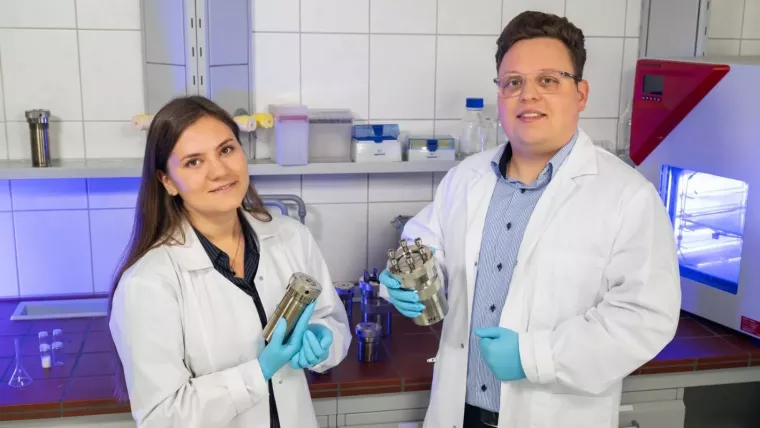Separating carbon dioxide molecules from gas mixtures necessitates the use of materials with extremely small pores. In collaboration with the Universities of Leipzig and Vienna, researchers from Friedrich Schiller University Jena have recently discovered a fresh method: they turned crystalline metal-organic framework compounds into glass. In doing so, scientists could shrink the pore size of the material to the point where it became impenetrable to particular gas molecules. Their findings are published in the journal Nature Materials.

Oksana Smirnova (left) and Dr Alexander Knebel (right) have developed innovative hybrid glasses. Image Credit: Jens Meyer (University of Jena)
Compressed Metal-Organic Frameworks
Actually, these glass-like materials were previously considered non-porous. The starting material, i.e., the crystalline framework compounds has very clearly defined pores and also a large internal surface area. Hence, they are also researched as materials for storing or separating gases. However, this defined structure is lost during melting and compression. And we took advantage of that.
Alexander Knebel, Study Lead and Junior Research Group Leader. Otto Schott Institute of the University of Jena
He added, “Metal-organic framework compounds consist of metal ions linked together by rigid organic molecules. In the spaces of these three-dimensional, regular grids, gas molecules can move easily. During the glass processing, we compressed the material. Put simply, we were able to squeeze the pores down to the desired size.”
Ordered Disorder
Certain portions of the crystal maintain their structure as the rest of the crystal melts away.
Knebel stated, “In technical terms, this means: during the transition from crystal to glass, the long-range order of the material is lost, but the short-range order is preserved.”
Oksana Smirnova, a doctoral student at the University of Jena and the lead author of the work, added, “When we now melt and compress this material, the porous interstices also change.”
Channels with restrictions or even dead ends are thereby produced, and as a result, some gases can no longer pass through.
With a tenth of a nanometer precision, the team was able to measure pore sizes in the material ranging from 0.27 to 0.32 nanometers.
“For illustration: This is about ten thousand times thinner than a human hair and a hundred times thinner than a DNA double helix. With this pore size, we were able to separate, for example, carbon dioxide from ethane. Our breakthrough in the field is probably the high quality of the glasses and the precise adjustability of the pore channels,” Knebel categorizes the work. “And our glasses are also several centimeters in size,” Knebel further added.
He concluded, “One goal of this work is to develop a glass membrane for environmental applications. Because separating carbon dioxide from gases is undoubtedly one of the great technological challenges of our time. That is why I am also grateful for the support of this work through the Breakthroughs Programme of the Carl Zeiss Foundation – and for the outstanding commitment of my doctoral student Oksana Smirnova, who contributed significantly to the success of this work.”
Journal Reference
Smirnova, O., et. al. (2023) Precise control over gas-transporting channels in zeolitic imidazolate framework glasses. Nature Materials. doi:10.1038/s41563-023-01738-3.
Article Revisions
- Jan 6 2025 - Meta Description has been updated to fall inline with Google recommendations and a malformed link has been repaired.